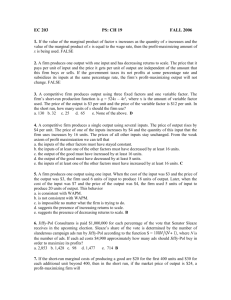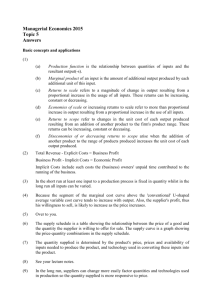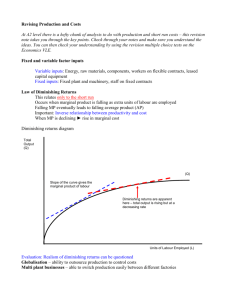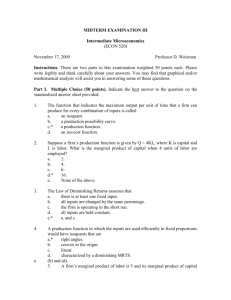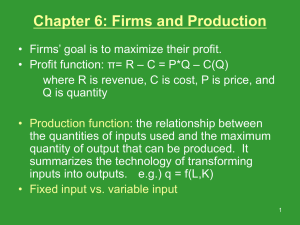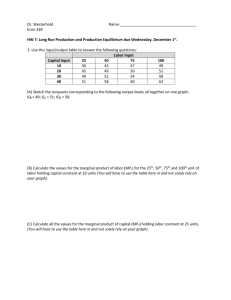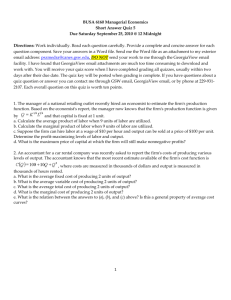Topic 6 – Production
advertisement
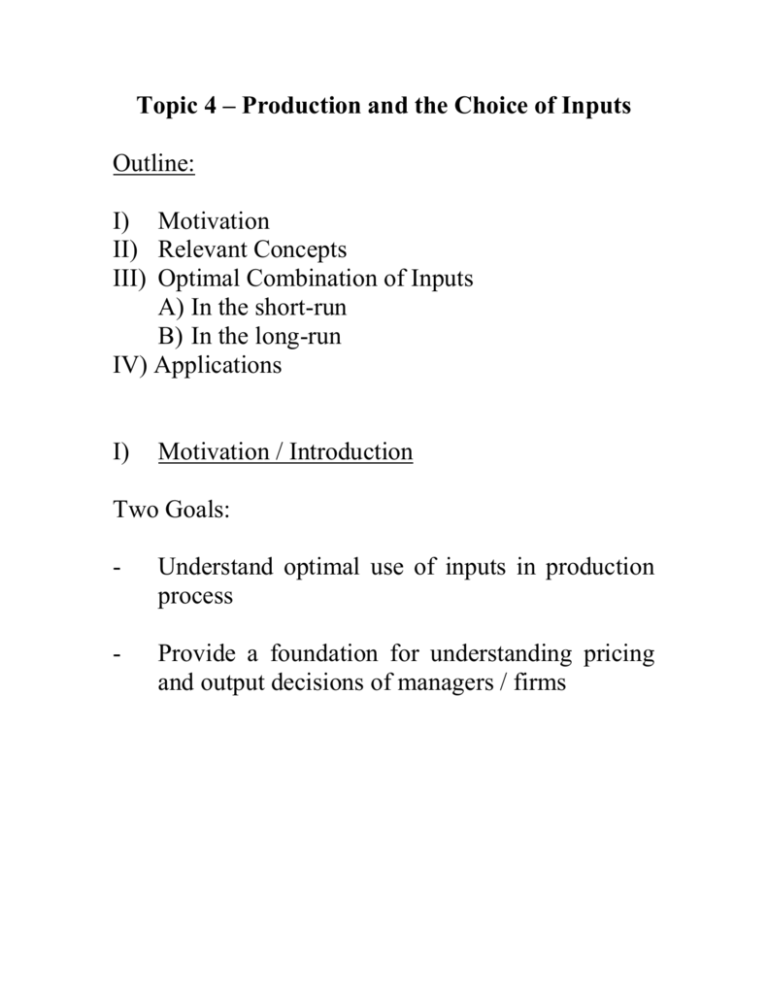
Topic 4 – Production and the Choice of Inputs Outline: I) Motivation II) Relevant Concepts III) Optimal Combination of Inputs A) In the short-run B) In the long-run IV) Applications I) Motivation / Introduction Two Goals: - Understand optimal use of inputs in production process - Provide a foundation for understanding pricing and output decisions of managers / firms II) Relevant Concepts (most of this should be review) - Need a mathematical description of the available production technology Production Function – An engineering relation that defines the maximum output that can be produced with a given set of inputs. Simplifying Assumption – Two inputs: Labor and Capital Example: Q F (K , L) The maximum amount of output Q that can be produced with K units of capital and L units of labor. - Manager’s job is to use the production technology efficiently, i.e. to determine how much of each input to use to produce a given level of output Two Relevant Time Horizons Short Run: Defined as the time period during which some inputs are fixed (e.g. assembly line at Ford) Long Run: All inputs are variable (i.e. can be adjusted) Usually, we assume that capital is fixed in the shortrun, while labor is variable Three Measures of Productivity A) Total Product – The maximum level of output that can be produced with a given amount of inputs. Example: Cobb-Douglas Production Function Q F (K , L) K .5L.5 Suppose K is fixed at 16 units. Short-Run production function is: Q (16).5 L.5 4L.5 Q: What is the total product when 100 units of labor are used? Q 4(100).5 40 units B) Average Product – A measure of the output produced per unit of input (average productivity of the input). Q Q AP , AP L L K K C) Marginal Product – The change in total output arising from a 1-unit change in one of the inputs, holding the quantity of the other input constant. Q MP , L L Q MP K K Stages of Production - Most inputs exhibit three stages of production, characterized by the value of their marginal product (holding constant the quantities of all other inputs). a) Increasing marginal returns – Initially, as the usage of an input increases, marginal product rises. b) Decreasing / Diminishing marginal returns – As more of the input is used, the marginal product typically begins to fall. c) Negative marginal returns – As greater quantities of the input is used, eventually the marginal product will become negative. Example: Assembly line workers Stages of Production Q Increasing Marginal Returns Diminishing Marginal Returns Negative Marginal Returns Q=F(K,L) =TP AP MP L Relationship between marginal and average product Notice that: When MP > AP, AP is rising When MP < AP, AP is falling When MP = AP, AP is at its maximum Example: GPAs and test scores Law of Diminishing (Marginal) Returns – Beyond some point, output grows at a diminishing rate with increases in the variable input. It has been said that, “if it weren’t for the law of diminishing returns, the whole world could be fed out of a flowerpot.” Returns to Scale Q: In the long-run (when all inputs are variable), what happens to output when all inputs are increased by exactly the same proportion? Increasing Returns to Scale – A proportional increase in all inputs yields a more than proportional increase in output (aka “Economies of Scale”). Constant Returns to Scale – A proportional increase in all inputs yields an equal proportional increase in output. Decreasing Returns to Scale – A proportional increase in all inputs yields a less than proportional increase in output (aka “Diseconomies of Scale”). Note: A production function can exhibit different degree of returns to scale over different levels of output. Common pattern: - Increasing returns to scale at low levels of output - Constant returns to scale at medium levels of output - Decreasing returns to scale at high levels of output Caveat: Decreasing returns to scale and the law of diminishing returns are completely unrelated! - “Decreasing returns to scale” is a long-run concept based on simultaneously varying all inputs. - “Diminishing returns” is short-run concept based on varying one input while all others are held fixed. III) Optimal Combination of Inputs A) In the Short-Run (capital fixed) With capital fixed, this reduces to asking how much labor should be hired? First, define a new concept… Value Marginal Product (VMP) – The value of the output produced by the last unit of an input. VMP P * MP L L VMP P * MP K K where P is the price the firm gets for it’s product. Note: Also sometimes referred to as the “marginal revenue product.” Profit-Maximizing Input Usage Rule: When the cost of each additional unit of labor is w, continue to hire labor up until the point where VMP w L (in the range of diminishing marginal product). This is just a form of the marginal benefit = marginal cost rule we saw earlier in the semester. Where VMP is the marginal benefit of hiring an L additional unit of labor and w is the marginal cost of hiring an additional unit of labor. Example 1: Quantity Of Labor 0 1 2 3 4 5 6 7 8 9 10 11 Price Of Output $3 3 3 3 3 3 3 3 3 3 3 3 MPL VMPL 76 172 244 292 316 316 292 244 172 76 -44 $228 516 732 876 948 948 876 732 516 228 -132 Wage Rate (weekly) $400 400 400 400 400 400 400 400 400 400 400 Initially, w > VMPL , but this is in the region where MPL is increasing Then, VMPL > w up through the 9th worker hired. Example 2: Price of output = $10 Q F (K , L) K1/ 2L1/ 2 Q: If capital is fixed at 1 unit in the short run, how much labor should the firm hire if the wage rate is $2 and the marginal product of labor is as shown below? K 1/ 2 MP L 2L1/ 2 Rule is: VMP w L in region where MPL is declining. Notice that MPL is everywhere declining in L. With K = 1, MP L 1 2L1/ 2 5 VMP L 1/ 2 L Then VMP w L 5 2 L1/ 2 L 25 6.25 4 Note: The downward-sloping portion of the VMPL is the firm’s labor demand curve. The fact that it is downward sloping follows from the property of diminishing marginal product. Thus, in the firm’s short-run labor demand curve will always be downward-sloping (in contrast to consumer demand curves). B) In the Long-Run (both inputs variable) Motivation 1) To maximize profits, the firm must produce its output in the least cost manner. 2) Cost-minimization is more fundamental than profit-maximization; applies to behavior of nonprofit organizations as well. We will study the manager’s cost minimization problem. Goal of the manager is to find the cost-minimizing combination of inputs to produce a given level of output. Manager’s cost-minimization problem is analogous to the consumer’s utility maximization problem that we saw earlier. Two familiar concepts: i) Isoquants (similar to indifference curves) ii) Isocost Line (similar to the budget line) “Iso” = “same” “Isoquant” = “same quantity” “Isocost” = “same cost” Isoquants - Defines the quantities of inputs (K,L) that yield the same level of output (Q). - Isoquants farther from the origin are associated wit higher levels of output. Marginal Rate of Technical Substitution (MRTS) – The rate at which a producer can substitute between two inputs and maintain the same level of output. - Given by the slope of the isoquant. Equal to the ratio of the marginal products. MP L MRTS KL MP K Law of Diminishing Marginal Rate of Technical Substitution – As less of one input is used, increasing amounts of another input must be used to produce the same level of output. - The more of one input you use, the less productive it is relative to the other input. - Yields typical “bowed-in” isoquants. Examples of Isoquants - Next page Linear Isoquants Capital and Labor are perfect substitutes K Increasing Output Q1 Q2 Q3 L Leontieff Isoquants Capital and labor are perfect complements, i.e. capital and labor are used in fixed proportions Q3 K Q2 Q1 Increasing Output L Benchmark Case Inputs are not perfectly K substitutable Q3 Q2 Diminishing marginal rate of technical substitution Increasing Output Q1 Most production processes have isoquants with this shape L Isocost Line - A line that represents the combinations of inputs (K,L) that cost the producer the same amount of money. - For given input prices, isocosts farther from the origin are associated with higher costs. - Equation similar to budget line: wL rK C - Slope of the isocost line is the ratio of the input prices. - To see this, rewrite equation as: K - C w L r r Changes in input prices rotate the isocost line (see diagram) Cost Minimization For typically-shaped isoquants, marginal product per dollar spent should be equal for all inputs MP MP L K w r Expressed differently MP L MRTS MP K w r Graphically, the cost-minimizing input combination occurs at a point of tangency between the isocost line and an isoquant. K Point of Cost Minimization Slope of Isocost = Slope of Isoquant Q L Optimal Input Substitution To minimize the cost the producing a given level of output, the firm should use less of an input whose relative price has risen (see diagram). Nothing akin to an income effect here; just a substitution effect. Long-run input demand curves are downward sloping. IV) Applications A) Fringe Benefit Costs and Labor Substitution. - Federal tax laws prevents firms from offering different benefit packages to high and low income workers. - Goal is to ensure that low-income workers receive adequate benefits. - Unintended consequences? - Consider a firm that employs programmers and secretaries. computer - Suppose programmers earn $60,000 per year while secretaries earn $20,000 per year. - Suppose that prior to the law, both types of workers have a health plan that costs 10% of their salary The programmers’ plan costs $6000 and the secretaries’ plan costs $2000. Relative price of a secretary to a programmer is 22,000/66,000 = .333 - Now suppose the tax law requires that both types of workers receive the same health plan. - Suppose the firm chooses a plan costing $4000. Q: What is the new relative price? A: Now, the relative price of a secretary is 24,000/64,000 = .375 - To minimize costs, firms will substitute away from secretaries (by hiring temps, contracting work out, or making secretaries part-time workers, etc.) Q: Does this really happen? A: See article by Scott, Berger, and Black, “Effects of the Tax Treatment of Fringe Benefits on Labor Market Segmentation.” B) Union support for minimum wage legislation. Q: Why do unions lobby for increases in the minimum wage when virtually all of their members already earn above the minimum wage?
